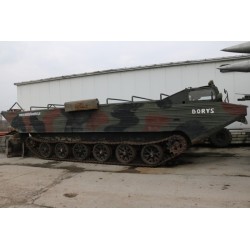





Polityka bezpieczeństwa (edytuj za pomocą modułu „Bezpieczeństwo klienta”)

Zasady dostawy (edytuj za pomocą modułu „Bezpieczeństwo klienta”)

Zasady zwrotu (edytuj za pomocą modułu „Bezpieczeństwo klienta”)
The PTS is a Soviet tracked amphibious transport. PTS stands for Plavayushchij Transportyer - Sryednyj or medium amphibious transport vehicle. Its industrial index was Ob'yekt 65.
Introduced in 1965, it is large, with a substantial payload of 10 tons, two to four times the capacity of the BAV 485, and better cross-country performance, at the cost of greater somewhat higher purchase costs because it is tracked. The most common model is the improved PTS-M that is powered by a 350 hp diesel engine.
It has a boxy, open watertight hull, with six road wheels per side, front drive sprocket,[1] rear idler sprocket, and no return rollers. Like the BAV 485, and unlike the DUKW, it has a rear loading ramp. The crew is seated at the front, leaving the rear of the vehicle open for a vehicle, which can be driven (or backed) in, rather than lifted over the side. To aid in facilitating this, the engine is under the floor.
Propulsion in water is by means of twin propellers, in tunnels to protect them from damage during land operations.
The PTS-M was adopted by the Soviet Army and Warsaw Pact forces, and has been supplied to Egypt, the former Yugoslavia, Iraq, Uruguay, and other nations.